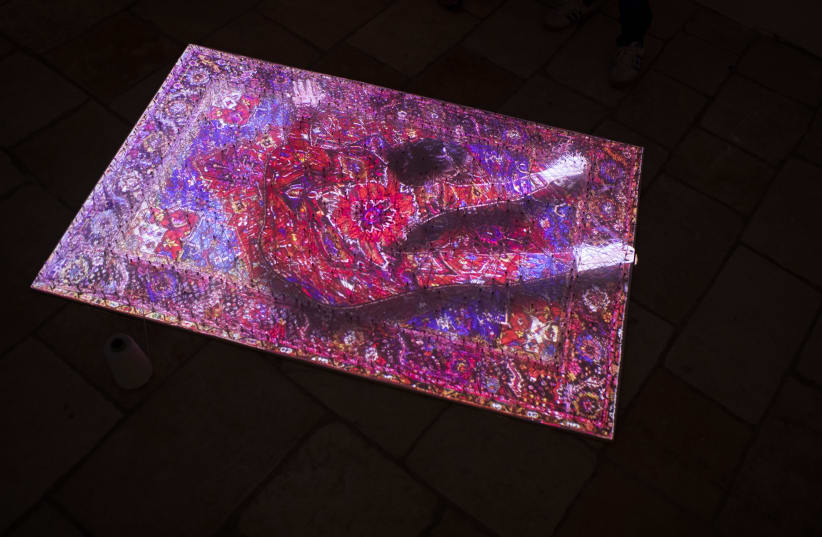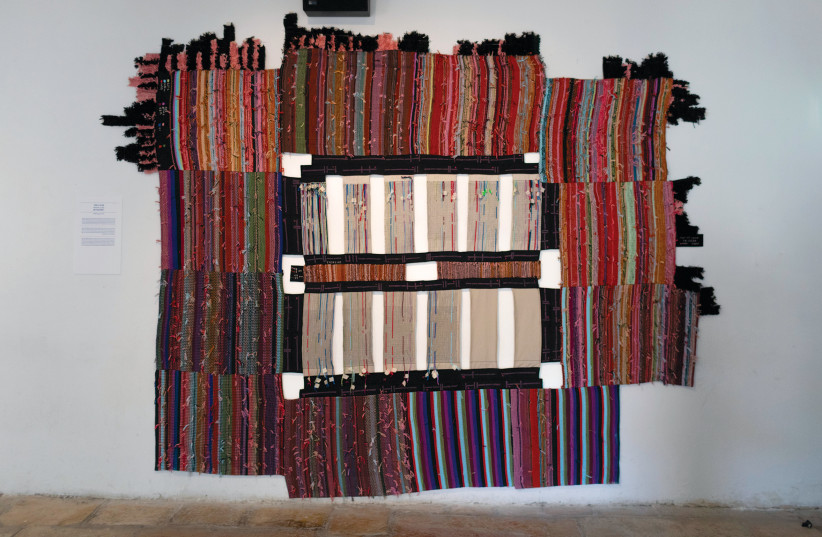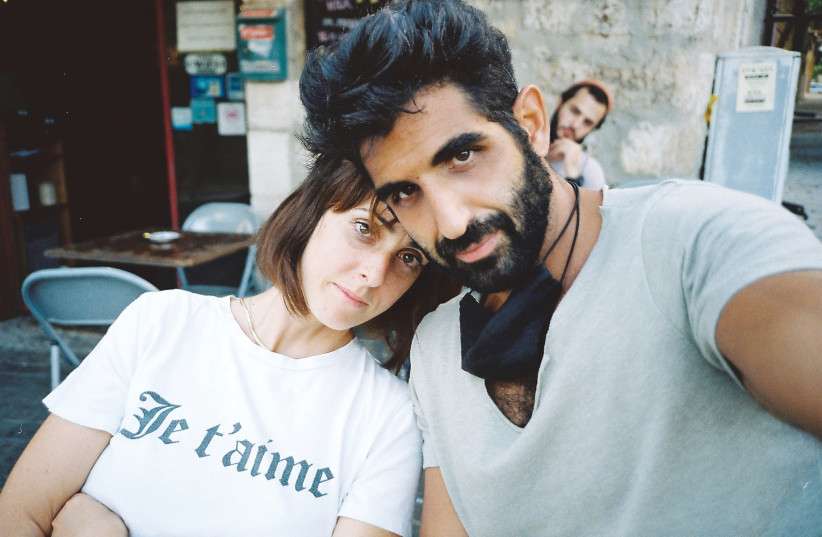The calmness of what was made out to be a frantic workspace was polarizing. Adi Yair, a fashion and textile designer, as well as Jerusalem native, raced against the clock as she worked. Yet, as the mix of Israeli and American music spilled softly through her radio speakers, the chocolate wafers she snacked on during the day melted in the sun, and not an ounce of worry crossed her face.
“Did you put the pins?” the 36-year-old asked her intern from behind her industrial sewing machine. The machine itself was old, made from metal that had long lost its sheen (unlike today’s machines, which are made with plastic). It sat on a small table with a few pieces of fabric on it. In the center of the workroom was a large table, bolts of fabric lodged in the shelves underneath, and the one being cut by the intern sprawled out.
On the other end of the room were two weaving looms; each a large wooden square device used to loop different threads over and under each other to create a textile. This is Yair’s specialty.
Yair studied law and mathematics in high school, a far cry from the design she does now. She did not get involved with artistry until her time in the IDF. “In the army, I served on a mountain with just a few people. And a friend of mine, she was drawing all the time. And then I said to myself, ‘I have nothing to do here. I’m stuck on a mountain, I can start drawing with her,’ and I liked it.”
After her service, Yair did some traveling and thought about what she wanted to do. “Someone asked me to be her model in her graduation event,” Yair said. She agreed and discovered she was interested in fashion.
She graduated with a bachelor’s degree from Bezalel Academy of Art and Design in 2013 and immediately opened a business. She worked for two seasons creating a women’s fashion brand.
IN FASHION, the change in seasons means a break in work. During the change, Yair began to have some free time. A friend working at Fifth Ward Gallery, a now-closed gallery in the Old City where she studied weaving with Yosef Gabso, told her there was a weaving machine there, a loom, “and that I need to come see it because I was obsessed with weaving.”
Gabso said that often people ask him to teach them to weave, but it’s less often that they follow through and learn. “You need a lot of passion because you [get] stuck all the time and you [need to] study how to fix it,” he said.
“You need a lot of passion because you [get] stuck all the time and you [need to] study how to fix it.”
Yosef Gabso
Yair didn’t know how to weave at the time, but she was fascinated with the grid patterns that weaving offered. She showed off the first piece she made, pulling it out of one of the closets in her workspace. An abstract black and white fabric made up a T-shirt. There was no sewing involved, as at the time she didn’t know how to sew, but she managed to utilize cuts in the fabric to create a woven pattern in the center of the shirt.
“Oh my God, I can create my own fabric,” she realized. Learning how to weave would allow her access to all the textures and fabric options she wanted.
She called Gabso and told him about her vision. They cut a deal. She could come to use the loom as much as she wanted, but in exchange she needed to explain and demonstrate to people how the machine worked.
The loom’s purpose was to weave prayer shawls, Yair said, but that was never something that she did.
She was a self-taught creator who discovered how to weave through experimenting on her own. “I tried to find my own language in weaving, and I made my first collection [where] I combined the weaving into the garments I made,” she said.
For about four months, she went to the gallery every day from 10 a.m. to 6 p.m. “At the beginning, I was walking through the Arab market, stopping to drink coffee at some shop,” she said.
But then, it was no longer safe for her to go that route. The “knife intifada,” a nine-month wave of violence mostly centered around Jerusalem, made it impossible for Yair to safely work.
“There was one month I didn’t [go] to the gallery. The first time I went back [to the gallery], I took the bus. When the bus stopped at the station, I just [went] back home because I was so afraid.” Eventually, colleagues and friends in the gallery picked her up and brought her home so she could work. She did that for about a month.
Gabso recounted, “In time, she asked me, ‘Yosef can you help me find a loom?’ I [saw] that she was very serious, and I was very happy.” He also mentioned that every once in a while, he still receives a phone call from Yair. If she’s stuck, she’ll call and ask him how to fix the loom.
But now she’s bought her own loom. “I renovated it with my dad, and then I opened a shop in the First Station,” she said. The shop was a cooperative that she shared with friends. She moved her loom there. The shop doubled as a workspace and a place to sell products.
“I always struggled because in Jerusalem there aren’t a lot of fashion lovers. So it was really hard to make money,” Yair admitted. She stayed in that space for about two years, with some of the time in the co-op but also on her own.
IN 2013, Yair met her husband, Tomer.
“I was his best friend,” Yair said. A photographer, Tomer took pictures of her work before they even started dating.
The two had a compelling love story that led back to Yair’s father, who had once dated Tomer’s aunt.
After their relationship got going, Tomer was extremely supportive, she said.
“It is so hard to [create]. Tomer sat [with me for] a few nights to [help me]... He helps me all the time,” she said, recalling when Tomer helped her finish a difficult piece she had a deadline for.
Yair developed many of her own patterns and techniques because those were things she picked up along the way as she learned to sew during her time at Bezalel. Now she has large binders filled with patterns she’s collected or created.
But weaving was always her favorite technique. She recalled developing a piece involving laser-cutting squares of fabric and using weaving techniques to connect them.
After the couple had their first child, Yair moved her workspace back to her childhood home. The family converted the basement into a space for them to live, and her workshop is in the heart of the garage outside.
That day, she had turned on a fan, but when fabric kept flying around, she was reminded why she doesn’t usually do that.
HER MOST recent piece was shown on June 23 at JLM Design Week at Beit Hanson.
One Year Carpet
One Year Carpet is a culmination of six parameters of her life. “When I wake up, when I go to sleep, when I go out, when I get in. How much time it takes me to put my daughter to sleep; then I just build it into carpets,” she explained.
Yair has a keen interest in carpet-making. Although she already has two degrees, she is looking into getting a third.
“In my profession, I always need to develop myself,” she said. She wants to do a doctorate in the textile and cultural fields. She also wants to study abroad. It would be the first time she would be leaving Jerusalem long term.
“I want to be Doctor of Carpets,” she said.
While studying for her master’s degree at Hebrew University, she was working on conceptualizing a copper-ink infused material that would have anti-viral properties. She wants to put it in public places such as train seats, especially in the wake of COVID-19. Now she is developing the start-up Cuver and looking for funding while she works on other projects.
Yair is also working on creating the costumes for Kolben Dance company’s production of Swan Lake. This year, she’ll be creating costumes for three choreographers.
“People ask me to do their dance costumes. I like doing that because it’s something that can be creative, so it’s nice,” she said.
Yair is busy, though. She also curated a “Paisley” exhibition for the Museum for Islamic Art this year. The museum director heard her name through the grapevine of mutual friends and offered her the job after seeing some of her work. The exhibition will be open until April 2023.
“I said yes because it’s a good opportunity. I never had an experience with curating, but it wasn’t easy,” she said. She is looking forward to doing more curating. She finds it a lot harder because it’s working on a computer all day, but she sees herself doing more of that in the future.
“I also want to work in the academy,” she said. Yair has big aspirations, and her family is very supportive. With her second child on the way, Yair’s plans have not been forced to take a back seat; it just means she is thinking about her family, too.
“I can create art without [having] to figure out where to [get] money or how to put food on the table.” She said that she and her husband both bring in money, but she does “what I love, so it doesn’t feel like work.”
Now Yair pays it forward by taking on interns to teach as well. Carly Kholos is an American fashion design student working for her this summer. “If I make a mistake, she’ll show me how to fix it, and [explain] what happened. She’s a great teacher,” she said. “Even when there’s issues, she still continues to work hard.”
Despite the trials and tribulations that come with being a designer in Jerusalem, Yair has no plans to leave the city that has shaped her success.
Because of her various degrees, she had the opportunity to study in Tel Aviv, but she expressed that her hesitation with the city is due to the money-focused mindset that comes along with it.
“I love to be out of the [central] area; I don’t want to live in Tel Aviv. Everybody is dealing with what they need to do to make money.... I want to make money from something else, and then I can create art,” she said. She wants her art to be a means of expressing herself and contributing to the world, not just a means to make money.
Likewise, she said that Jerusalem is not a place for a fashion designer, but the city has provided the space for her to develop as an artist. From friends calling her to give her opportunities to learn to weave and curate, to her stores and exhibitions being part of the local scene, Yair has found a home for her creativity that has allowed her to grow and experience things she may not have otherwise done.
For a woman who has lived in the same place her whole life, it has never held her back, only allowed her to flourish.
“I love and hate Jerusalem, but I couldn’t imagine myself living anywhere else.” ❖


